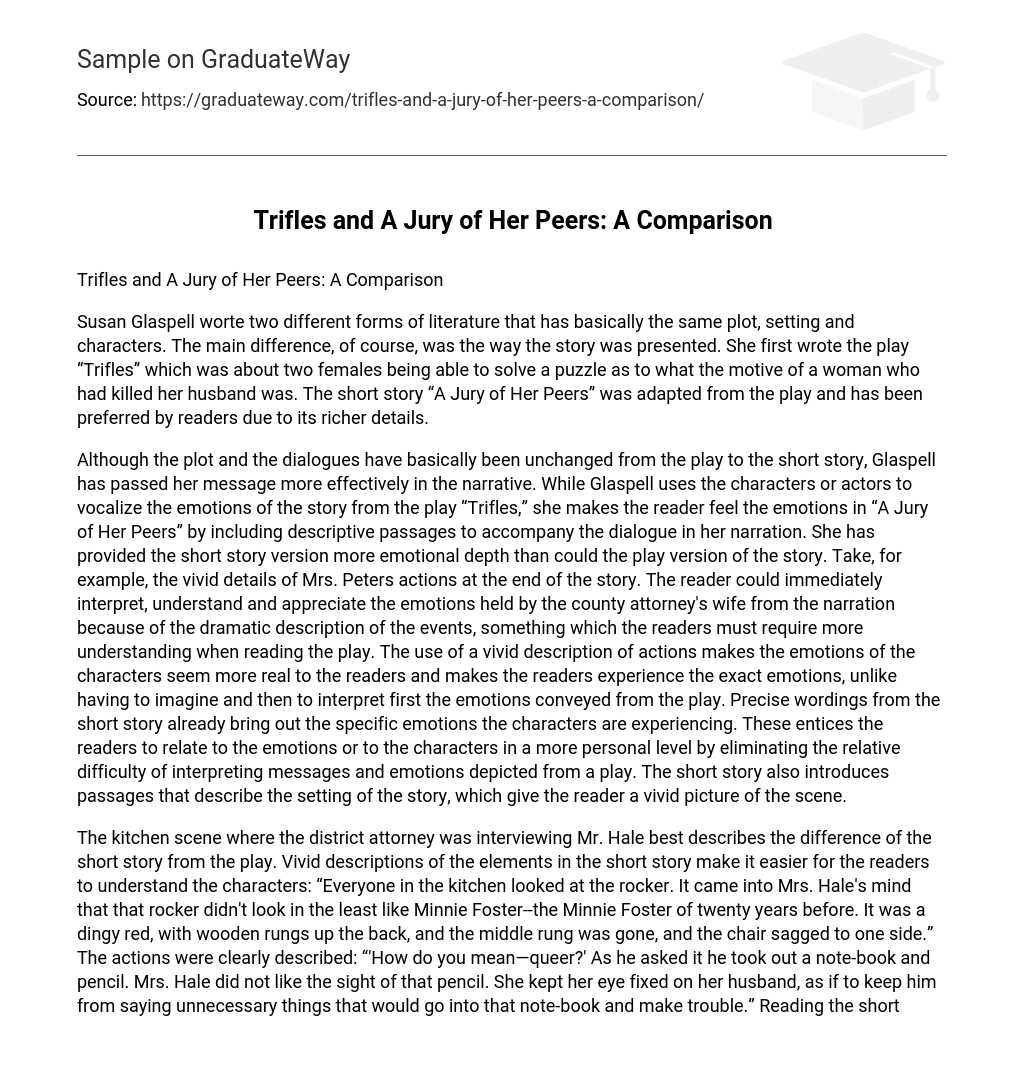Susan Glaspell worte two different forms of literature that has basically the same plot, setting and characters. The main difference, of course, was the way the story was presented. She first wrote the play “Trifles” which was about two females being able to solve a puzzle as to what the motive of a woman who had killed her husband was. The short story “A Jury of Her Peers” was adapted from the play and has been preferred by readers due to its richer details.
Although the plot and the dialogues have basically been unchanged from the play to the short story, Glaspell has passed her message more effectively in the narrative. While Glaspell uses the characters or actors to vocalize the emotions of the story from the play “Trifles,” she makes the reader feel the emotions in “A Jury of Her Peers” by including descriptive passages to accompany the dialogue in her narration. She has provided the short story version more emotional depth than could the play version of the story. Take, for example, the vivid details of Mrs. Peters actions at the end of the story. The reader could immediately interpret, understand and appreciate the emotions held by the county attorney’s wife from the narration because of the dramatic description of the events, something which the readers must require more understanding when reading the play. The use of a vivid description of actions makes the emotions of the characters seem more real to the readers and makes the readers experience the exact emotions, unlike having to imagine and then to interpret first the emotions conveyed from the play. Precise wordings from the short story already bring out the specific emotions the characters are experiencing. These entices the readers to relate to the emotions or to the characters in a more personal level by eliminating the relative difficulty of interpreting messages and emotions depicted from a play. The short story also introduces passages that describe the setting of the story, which give the reader a vivid picture of the scene.
The kitchen scene where the district attorney was interviewing Mr. Hale best describes the difference of the short story from the play. Vivid descriptions of the elements in the short story make it easier for the readers to understand the characters: “Everyone in the kitchen looked at the rocker. It came into Mrs. Hale’s mind that that rocker didn’t look in the least like Minnie Foster–the Minnie Foster of twenty years before. It was a dingy red, with wooden rungs up the back, and the middle rung was gone, and the chair sagged to one side.” The actions were clearly described: “’How do you mean—queer?’ As he asked it he took out a note-book and pencil. Mrs. Hale did not like the sight of that pencil. She kept her eye fixed on her husband, as if to keep him from saying unnecessary things that would go into that note-book and make trouble.” Reading the short story immediately makes the reader understand that Mr. Hale was somewhat reluctant, guarding his words while he relate his story: “Hale did speak guardedly, as if the pencil had affected him too.” Reading the short story version makes the story in the play seem dull.
The lack of details in the play “Trifles” is an obvious disadvantage which needs the interpretation of the readers. It requires a wider range of imagination than something that has already been offered to the readers, as in the case of the short story. The short story, of course, is easier to interpret as easily as it can be appreciated. The description of the character’s emotions and actions on a short story makes it less difficult for the readers to understand what is really happening in the story. Compared to the play, short stories require less imagination as the details have already been supplied by the author. Of course, there are some elements, both from the short story and the play, that requires understanding from the readers, like the symbols used and their meaning, or the overall message of the story. But for reading purposes, the short story offers a more fulfilling satisfaction. It can more successfully convey the emotions of the characters, the reasons for their actions and message of the story than reading the play version. A play, after all, is intended and much more appreciated “acted on stage.”
Works Cited
Glaspell, Susan. “A Jury of Her Peers.”
Glaspell, Susan. “Trifles.”





